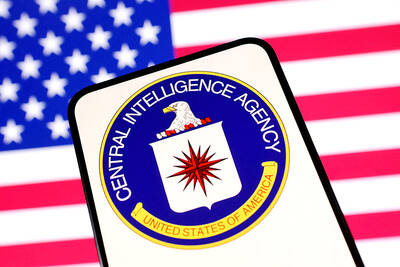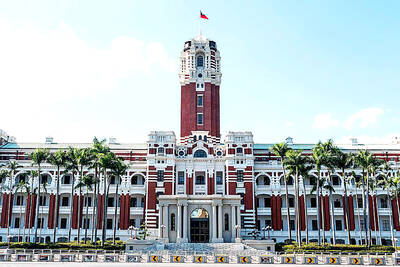The US has spent hundreds of millions of dollars trying to develop early warning detectors for biological attacks -- on Friday it erected some around the Pentagon -- but so far the systems are far from perfect, scientists say.
The fact that people infected with anthrax are likely to survive if they are promptly treated has reinforced the broad agreement among scientists that the best defense against a biological attack is an early warning system. But designing and building such a system has proven difficult. Current detection systems, like the devices put around the Pentagon, are bulky, expensive, slow to discern problems and prone to false warnings.
Experts say they are years away from achieving their goal -- the equivalent of a smoke detector for biological weapons. But if they could produce such a device, it could transform some threats, like anthrax, from weapons of mass destruction to scary nuisances.
Without stealth, anthrax makes for a feeble weapon. If treatment begins promptly after exposure, almost everyone exposed to anthrax survives, even those who have inhaled spores.
But in an attack, a cloud of finely milled anthrax would descend, invisible and odorless. People would eventually turn up at doctors' offices and hospitals, reporting symptoms like those of the flu. By the time the proper diagnosis was made, perhaps days later, the anthrax spores would have germinated into bacteria, the bacteria would be producing toxins and the toxins would be doing their deadly work in the body.
"Almost always it's too late," said Dr. Alan P. Zelicoff, a physician and expert on biological arms at the Sandia National Laboratory in Albuquerque, N.M.
So for a biological attack, experts agree, warning systems are crucial.
New-age smoke detector
The ideal, they say, would be something that works like a smoke detector, an inexpensive device that quietly samples the air and sounds a warning when something dangerous is found. But scientists and engineers say they are far from designing a device that can pick out deadly bacteria and viruses.
"I don't think we're anywhere near the smoke detector for bio," said Dr. Stephen S. Morse, director of the Center for Public Health Preparedness at Columbia University, who once ran a Pentagon research program on ways to detect and diagnose pathogens.
The biggest problem is differentiating between the hordes of harmless germs normally in the air from dangerous bacteria -- often their close relatives.
The military has spent millions of dollars to develop detectors. The truck-based system stationed at the Pentagon can identify four biological agents in less than 45 minutes, according to the latest annual report from the Pentagon to Congress on the status of chemical and biological defenses. Some air bases use a network of these sensors and compare their readings, to cut down on false warnings.
Another system tries to use light to detect aerosol clouds from kilometers away, but it cannot tell whether the clouds contain pathogens.
The Pentagon's inspector general last year criticized development of a new, more advanced system known as the Joint Biological Point Detection System for achieving only one of 10 critical goals. It broke down often, failed to identify lethal pathogens and sometimes gave false warnings when no danger existed.
That report was based on two-year-old data, and "In the last two years, we have made significant progress," said Colonel Stephen V. Reeves of the Army, who manages the Joint Program Office for Biological Defense. Eleven units, which weigh about 136kg each, are being evaluated at the Dugway Proving Grounds in Utah. Reeves said he believed the system was "very close" to meeting all of the critical goals, including a 90 percent accuracy rate.
Meanwhile, the Department of Energy is trying use off-the-shelf technology to build a system for use in civilian areas like airports, stadiums and subways. It hopes to use the system during the Winter Olympics next February in Salt Lake City, said Dr. Richard Wheeler, a technical adviser to the department's Chemical and Biological National Security Program.
This system uses air samplers similar to those already used to monitor air pollution. They suck in air and deposit any particles on a filter or in a liquid. The particles are counted automatically; an increase is a sign that an attack has occurred.
But to know what has actually been in the air, samples must be removed from the unit periodically and taken to a laboratory for genetic testing. Results would not be available for hours, Wheeler said. Such a system would not warn people in time to evacuate, but it could give them enough notice to be treated for exposure, he said.
The next generation system, being developed at Lawrence Livermore National Laboratory, would be autonomous. The system draws in air and traps the particles in a liquid, which then flows past tiny beads coated with antibodies that hook onto only certain pathogens. A second genetic test would confirm results. Dr. Richard G. Langlois, a senior biomedical scientist at Livermore, said scientists at the laboratory hoped to have a prototype within a year.
Personal protection
It is far simpler to conduct a one-time test to detect a specific type of bacteria, and a North Carolina company plans to market a home test for anthrax this year for about US$25.
The company, Vital Living Products, in Matthews, began adapting a test for a common bacteria, coliform, for use as an anthrax detector the day after the Sept. 11 terrorist attacks. In its test, the company said, water and chemical reagents are mixed in a bottle and left in a room for half an hour to collect particles from the air. Then the bottle is closed and shaken, turning the liquid bright red. Anthrax bacteria or spores would set off chemical reactions that change the color to yellow in one to two days.
Still, those tests are of no help without the suspicion that an attack has taken place.
Calvin Chue, a research scientist at the Center for Civilian Biodefense Studies at Johns Hopkins University, said that in three to five years, so- called DNA chips, which contain snippets of genetic code, might be able to detect virtually all pathogens based on their genetic signatures.
Scientists are working to automate speed up, and shrink the size and cost of the devices. Livermore has developed a handheld device to test for pathogens, with results coming in half an hour. But it can test for up to only four pathogens at a time and requires a trained technician. The laboratory is licensing it to the Environmental Technologies Group of Baltimore, which hopes to have a product within a year, Langlois said.
In the absence of detectors of an attack itself, the next line of defense would be a surveillance system that would alert health officials to clusters of people coming down with unusual symptoms.
At present, the Centers for Disease Control and Prevention in Atlanta looks at patterns of disease in reports that percolate up from doctors to local and state public health officials.
A perhaps fanciful idea would be to deploy sentinel animals, much like the coal mine canaries that died quickly if noxious gases started seeping in. Some people have recommended stationing guinea pigs or mice in strategic locations, because the animals can become sick if they inhale even a few anthrax spores.
A futuristic idea is to use living tissues, sometimes connected to electronic chips, as sensors. Scientists at MIT. Lincoln Laboratory are developing a system known as Canary in which human immune cells are genetically engineered to latch onto pathogens and emit a signal when they do.
Systems for private homes are a long way off. Wheeler said the Energy Department hoped to get the systems down to a few thousand dollars. But, he said, "It's not going to be US$29.95 at Wal-Mart."

The CIA has a message for Chinese government officials worried about their place in Chinese President Xi Jinping’s (習近平) government: Come work with us. The agency released two Mandarin-language videos on social media on Thursday inviting disgruntled officials to contact the CIA. The recruitment videos posted on YouTube and X racked up more than 5 million views combined in their first day. The outreach comes as CIA Director John Ratcliffe has vowed to boost the agency’s use of intelligence from human sources and its focus on China, which has recently targeted US officials with its own espionage operations. The videos are “aimed at

STEADFAST FRIEND: The bills encourage increased Taiwan-US engagement and address China’s distortion of UN Resolution 2758 to isolate Taiwan internationally The Presidential Office yesterday thanked the US House of Representatives for unanimously passing two Taiwan-related bills highlighting its solid support for Taiwan’s democracy and global participation, and for deepening bilateral relations. One of the bills, the Taiwan Assurance Implementation Act, requires the US Department of State to periodically review its guidelines for engagement with Taiwan, and report to the US Congress on the guidelines and plans to lift self-imposed limitations on US-Taiwan engagement. The other bill is the Taiwan International Solidarity Act, which clarifies that UN Resolution 2758 does not address the issue of the representation of Taiwan or its people in

US Indo-Pacific Commander Admiral Samuel Paparo on Friday expressed concern over the rate at which China is diversifying its military exercises, the Financial Times (FT) reported on Saturday. “The rates of change on the depth and breadth of their exercises is the one non-linear effect that I’ve seen in the last year that wakes me up at night or keeps me up at night,” Paparo was quoted by FT as saying while attending the annual Sedona Forum at the McCain Institute in Arizona. Paparo also expressed concern over the speed with which China was expanding its military. While the US

SHIFT: Taiwan’s better-than-expected first-quarter GDP and signs of weakness in the US have driven global capital back to emerging markets, the central bank head said The central bank yesterday blamed market speculation for the steep rise in the local currency, and urged exporters and financial institutions to stay calm and stop panic sell-offs to avoid hurting their own profitability. The nation’s top monetary policymaker said that it would step in, if necessary, to maintain order and stability in the foreign exchange market. The remarks came as the NT dollar yesterday closed up NT$0.919 to NT$30.145 against the US dollar in Taipei trading, after rising as high as NT$29.59 in intraday trading. The local currency has surged 5.85 percent against the greenback over the past two sessions, central